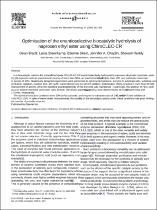 ResearchSpace
ResearchSpace
Optimisation of the enantioselective biocatalytic hydrolysis of naproxen ethyl ester using ChiroCLEC-CR
JavaScript is disabled for your browser. Some features of this site may not work without it.
- ResearchSpace
- →
- Research Publications/Outputs
- →
- Journal Articles
- →
- View Item
| dc.contributor.author |
Brady, D

|
en_US |
| dc.contributor.author |
Steenkamp, Lucia H

|
en_US |
| dc.contributor.author |
Skein, E

|
en_US |
| dc.contributor.author |
Chaplin, JA

|
en_US |
| dc.contributor.author |
Reddy, S

|
en_US |
| dc.date.accessioned | 2007-01-11T11:55:30Z | en_US |
| dc.date.accessioned | 2007-06-07T10:04:54Z | |
| dc.date.available | 2007-01-11T11:55:30Z | en_US |
| dc.date.available | 2007-06-07T10:04:54Z | |
| dc.date.issued | 2004-03-04 | en_US |
| dc.identifier.citation | Brady, D et al. 2004. Optimisation of the enantioselective biocatalytic hydrolysis of naproxen ethyl ester using ChiroCLEC-CR. Enzyme and microbial technology, vol 34, 4 March, pp 283-291 | en_US |
| dc.identifier.issn | 0141-0229 | en_US |
| dc.identifier.uri | http://hdl.handle.net/10204/1381 | en_US |
| dc.identifier.uri | http://hdl.handle.net/10204/1381 | |
| dc.description.abstract | In a biocatalytic reaction the immobilized lipase ChiroCLEC-CR enantioselectively hydrolysed a naproxen ethyl ester racemate, yielding (S)-naproxen with an enantiomeric excess of more than 98%, an enantiomeric ratio (E) of more than 100, and substrate conversion in excess of 40%. Statistically designed experiments were performed to optimise temperature, enzyme to substrate ratio, substrate concentration, agitation, reaction time, pH, buffer concentration and co-solvent addition. Optimisation efforts resulted in more than 20-fold improvement of activity, while the excellent enantioselectivity of the enzymes was maintained. In particular, the addition of PEG 1000 as a co-solvent improved conversion rates 10-fold. The kinetic parameters V-max and K-M were determined to be 0.359_mol/min/mg and 17.6 mM, respectively. The optimised reaction conditions were 10% (m/v) substrate, and enzyme to substrate ratio of 1:50, at 50 degrees C and pH 5 with addition of 41% PEG 1000. In spite of these kinetic improvements, the stability of the biocatalytic activity under these conditions was poor, limiting the number of possible recycles. | en_US |
| dc.format.extent | 185111 bytes | en_US |
| dc.format.mimetype | application/pdf | en_US |
| dc.language.iso | en | en_US |
| dc.publisher | Elsevier Science Inc. | en_US |
| dc.rights | Copyright: 2004 Elsevier Inc. | en_US |
| dc.subject | Candida rugosa lipase | en_US |
| dc.subject | Enantioselectivity | en_US |
| dc.subject | ChiroCLEC-CR | en_US |
| dc.subject | Hydrolysis | en_US |
| dc.subject | Naproxen ester | en_US |
| dc.subject | S-Naproxen | en_US |
| dc.subject | Biotechnology | en_US |
| dc.subject | Applied microbiology | en_US |
| dc.title | Optimisation of the enantioselective biocatalytic hydrolysis of naproxen ethyl ester using ChiroCLEC-CR | en_US |
| dc.type | Article | en_US |
| dc.identifier.apacitation | Brady, D., Steenkamp, L. H., Skein, E., Chaplin, J., & Reddy, S. (2004). Optimisation of the enantioselective biocatalytic hydrolysis of naproxen ethyl ester using ChiroCLEC-CR. http://hdl.handle.net/10204/1381 | en_ZA |
| dc.identifier.chicagocitation | Brady, D, Lucia H Steenkamp, E Skein, JA Chaplin, and S Reddy "Optimisation of the enantioselective biocatalytic hydrolysis of naproxen ethyl ester using ChiroCLEC-CR." (2004) http://hdl.handle.net/10204/1381 | en_ZA |
| dc.identifier.vancouvercitation | Brady D, Steenkamp LH, Skein E, Chaplin J, Reddy S. Optimisation of the enantioselective biocatalytic hydrolysis of naproxen ethyl ester using ChiroCLEC-CR. 2004; http://hdl.handle.net/10204/1381. | en_ZA |
| dc.identifier.ris | TY - Article AU - Brady, D AU - Steenkamp, Lucia H AU - Skein, E AU - Chaplin, JA AU - Reddy, S AB - In a biocatalytic reaction the immobilized lipase ChiroCLEC-CR enantioselectively hydrolysed a naproxen ethyl ester racemate, yielding (S)-naproxen with an enantiomeric excess of more than 98%, an enantiomeric ratio (E) of more than 100, and substrate conversion in excess of 40%. Statistically designed experiments were performed to optimise temperature, enzyme to substrate ratio, substrate concentration, agitation, reaction time, pH, buffer concentration and co-solvent addition. Optimisation efforts resulted in more than 20-fold improvement of activity, while the excellent enantioselectivity of the enzymes was maintained. In particular, the addition of PEG 1000 as a co-solvent improved conversion rates 10-fold. The kinetic parameters V-max and K-M were determined to be 0.359_mol/min/mg and 17.6 mM, respectively. The optimised reaction conditions were 10% (m/v) substrate, and enzyme to substrate ratio of 1:50, at 50 degrees C and pH 5 with addition of 41% PEG 1000. In spite of these kinetic improvements, the stability of the biocatalytic activity under these conditions was poor, limiting the number of possible recycles. DA - 2004-03-04 DB - ResearchSpace DP - CSIR KW - Candida rugosa lipase KW - Enantioselectivity KW - ChiroCLEC-CR KW - Hydrolysis KW - Naproxen ester KW - S-Naproxen KW - Biotechnology KW - Applied microbiology LK - https://researchspace.csir.co.za PY - 2004 SM - 0141-0229 T1 - Optimisation of the enantioselective biocatalytic hydrolysis of naproxen ethyl ester using ChiroCLEC-CR TI - Optimisation of the enantioselective biocatalytic hydrolysis of naproxen ethyl ester using ChiroCLEC-CR UR - http://hdl.handle.net/10204/1381 ER - | en_ZA |





